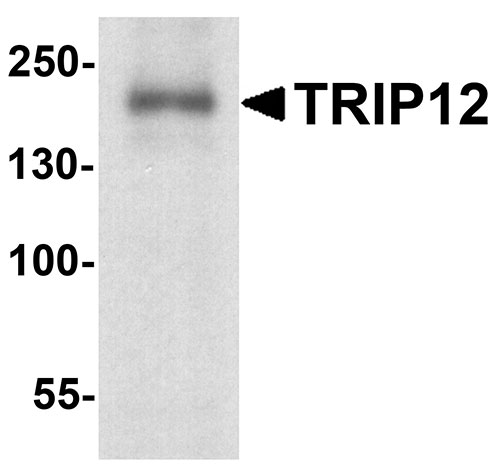TRIP12 Antibody
- 产品详情
- 实验流程
- 背景知识
Application
| WB, IF, E, IHC-P |
|---|---|
| Primary Accession | Q14669 |
| Other Accession | NP_004229, 10863903 |
| Reactivity | Human, Mouse, Rat |
| Host | Rabbit |
| Clonality | Polyclonal |
| Isotype | IgG |
| Calculated MW | 220434 Da |
| Concentration (mg/ml) | 1 mg/mL |
| Conjugate | Unconjugated |
| Application Notes | TRIP12 antibody can be used for detection of TRIP12 by Western blot at 1 - 2 µg/ml. Antibody can also be used for Immunohistochemistry starting at 5 µg/mL. For immunofluorescence start at 20 µg/mL. |
| Gene ID | 9320 |
|---|---|
| Other Names | E3 ubiquitin-protein ligase TRIP12, 6.3.2.-, E3 ubiquitin-protein ligase for Arf, ULF, Thyroid receptor-interacting protein 12, TR-interacting protein 12, TRIP-12, TRIP12, KIAA0045, ULF |
| Target/Specificity | TRIP12; TRIP12 antibody is human, mouse and rat reactive. At least four isoforms are known to exist. |
| Reconstitution & Storage | TRIP12 antibody can be stored at 4℃ for three months and -20℃, stable for up to one year. |
| Precautions | TRIP12 Antibody is for research use only and not for use in diagnostic or therapeutic procedures. |
| Name | TRIP12 |
|---|---|
| Synonyms | KIAA0045, ULF |
| Function | E3 ubiquitin-protein ligase involved in ubiquitin fusion degradation (UFD) pathway and regulation of DNA repair (PubMed:19028681, PubMed:22884692). Part of the ubiquitin fusion degradation (UFD) pathway, a process that mediates ubiquitination of protein at their N-terminus, regardless of the presence of lysine residues in target proteins (PubMed:19028681). Acts as a key regulator of DNA damage response by acting as a suppressor of RNF168, an E3 ubiquitin-protein ligase that promotes accumulation of 'Lys-63'-linked histone H2A and H2AX at DNA damage sites, thereby acting as a guard against excessive spreading of ubiquitinated chromatin at damaged chromosomes (PubMed:22884692). In normal cells, mediates ubiquitination and degradation of isoform p19ARF/ARF of CDKN2A, a lysine-less tumor suppressor required for p53/TP53 activation under oncogenic stress (PubMed:20208519). In cancer cells, however, isoform p19ARF/ARF and TRIP12 are located in different cell compartments, preventing isoform p19ARF/ARF ubiquitination and degradation (PubMed:20208519). Does not mediate ubiquitination of isoform p16-INK4a of CDKN2A (PubMed:20208519). Also catalyzes ubiquitination of NAE1 and SMARCE1, leading to their degradation (PubMed:18627766). Ubiquitination and degradation of target proteins is regulated by interaction with proteins such as MYC, TRADD or SMARCC1, which disrupt the interaction between TRIP12 and target proteins (PubMed:20829358). Mediates ubiquitination of ASXL1: following binding to N(6)-methyladenosine methylated DNA, ASXL1 is ubiquitinated by TRIP12, leading to its degradation and subsequent inactivation of the PR-DUB complex (PubMed:30982744). |
| Cellular Location | Nucleus, nucleoplasm |
For Research Use Only. Not For Use In Diagnostic Procedures.
Provided below are standard protocols that you may find useful for product applications.
BACKGROUND
Thyroid hormone receptors (TRs) are transcription factors that regulate the expression of specific genes in a hormone-dependent manner (1). TRIP12 (thyroid hormone receptor interactor 12) is an ATP-dependent E3 ubiquitin ligase involved in the human ubiquitin fusion degradation (UFD) pathway and also modulates the NEDD8 pathway (2,3). TRIP12 contains one WWE domain and a single HECT (E6AP-type E3 ubiquitin-protein ligase) domain suggested to contain a noncovalent ubiquitin-binding site (4). TRIP12 acts as a key regulator of DNA damage response and the ubiquitin ligase activity of TRIP12 is essential for mouse development (5).
REFERENCES
Lee JW, Choi HS, Gyuris J, et al. Two classes of proteins dependent on either the presence or absence of thyroid hormone for interaction with the thyroid hormone receptor. Mol. Endocrinol. 1995; 9:243–54.
An CI, Ganio E, and Hagiwara N. Trip12, a HECT domain E3 ubiquitin ligase, targets Sox6 for proteasomal degradation and affects fiber type-specific gene expression in muscle cells. Skelet. Muscle 2013; 3:11.
Poulsen EG, Steinhauer C, Lees M, et al. HUWE1 and TRIP12 collaborate in degradation of ubiquitin-fusion proteins and misframed ubiquitin. PLoS One. 2012; 7:e50548.
Park Y, Yoon SK, and Yoon JB. The HECT domain of TRIP12 ubiquitinates substrates of the ubiquitin fusion degradation pathway. J. Biol. Chem. 2009; 284:1540-9.
终于等到您。ABCEPTA(百远生物)抗体产品。
点击下方“我要评价 ”按钮提交您的反馈信息,您的反馈和评价是我们最宝贵的财富之一,
我们将在1-3个工作日内处理您的反馈信息。
如有疑问,联系:0512-88856768 tech-china@abcepta.com.























 癌症的基本特征包括细胞增殖、血管生成、迁移、凋亡逃避机制和细胞永生等。找到癌症发生过程中这些通路的关键标记物和对应的抗体用于检测至关重要。
癌症的基本特征包括细胞增殖、血管生成、迁移、凋亡逃避机制和细胞永生等。找到癌症发生过程中这些通路的关键标记物和对应的抗体用于检测至关重要。 为您推荐一个泛素化位点预测神器——泛素化分析工具,可以为您的蛋白的泛素化位点作出预测和评分。
为您推荐一个泛素化位点预测神器——泛素化分析工具,可以为您的蛋白的泛素化位点作出预测和评分。 细胞自噬受体图形绘图工具为你的蛋白的细胞受体结合位点作出预测和评分,识别结合到自噬通路中的蛋白是非常重要的,便于让我们理解自噬在正常生理、病理过程中的作用,如发育、细胞分化、神经退化性疾病、压力条件下、感染和癌症。
细胞自噬受体图形绘图工具为你的蛋白的细胞受体结合位点作出预测和评分,识别结合到自噬通路中的蛋白是非常重要的,便于让我们理解自噬在正常生理、病理过程中的作用,如发育、细胞分化、神经退化性疾病、压力条件下、感染和癌症。








